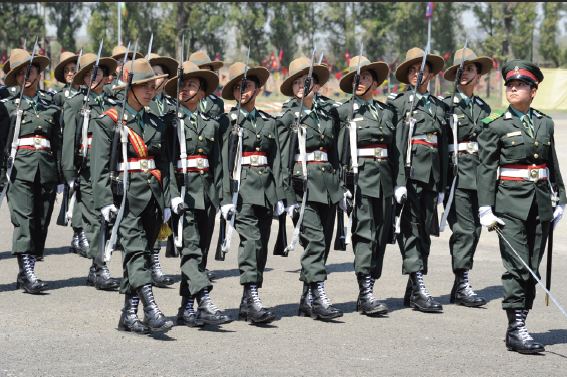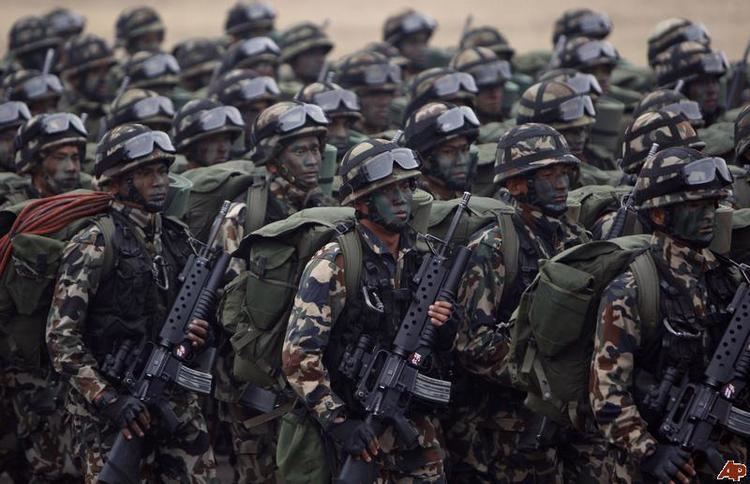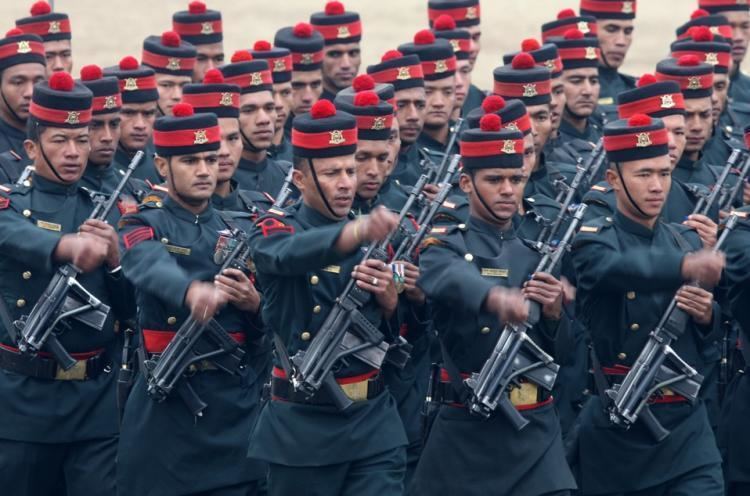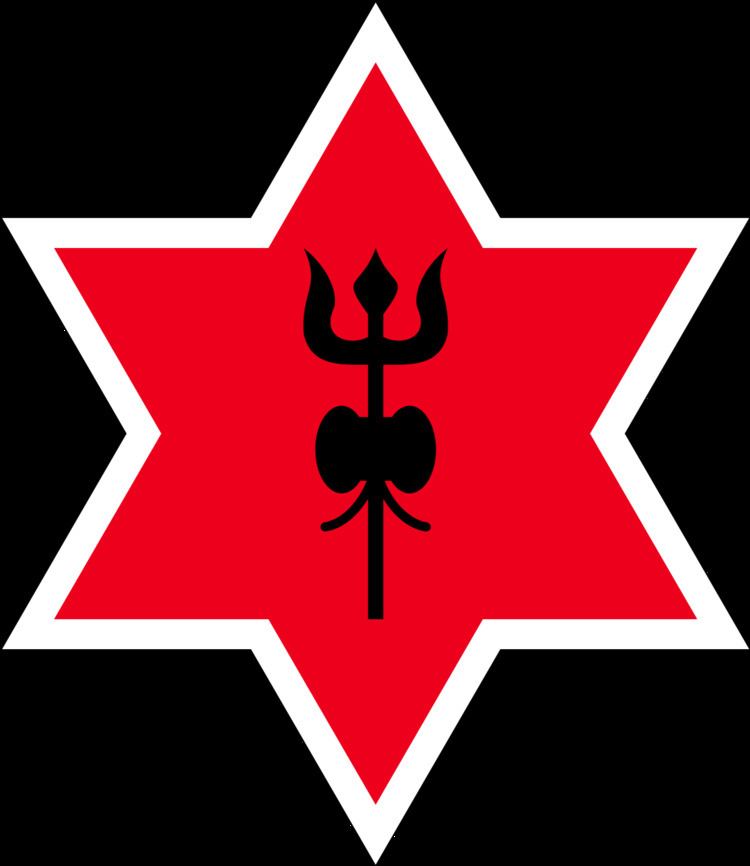Headquarters Kathmandu | ||
 | ||
Similar Nepalese Armed Forces, Indian Army, British Indian Army, British Army, Indian Armed Forces Profiles | ||
The Nepalese Army (Nepali: नेपाली सेना) is the armed military Land warfare force of Nepal available internationally and a major component of the Military of Nepal. Service is voluntary and the minimum age for enrollment is 18 years. The army was known as The Royal Nepalese Army (RNA) during the monarchy system in Nepal. It was renamed into Nepalese Army since 28 May 2008 with the abolishing of 238-year-old monarchy.
Contents
- History
- Organization
- Supreme Command
- The National Defence Council
- Divisions
- Operations
- Foreign Involvements
- Domestic Operations
- International Operations
- USNepal military relations
- Bases
- Schools
- Units
- Equipment
- Uniform
- Formal Dress
- Combat Dress
- Rank Structure
- Chiefs of the Army Staff
- Battles
- Battles on Defending Kingdom of Nepal
- Medals and Awards
- References

History

Nepal unification campaign was a turning point in the history of the Nepalese army. Since unification was not possible without a strong army, the management of the armed forces had to be exceptional. Apart from the standard Malla era temples in Kathmandu, army being organized in Gorkhas, technicians and experts had to be brought in from abroad to manufacture war materials. After the Gorkhali troops captured Nuwakot, the neighbouring principality of Kathmandu (Kantipur) in the year 1744, the Gorkhali armed forces came to be known as the Royal Nepalese Army.

Their gallantry, sincerity and simplicity impressed even their enemy so much that the British East-India Company started recruiting Nepalese into their forces. Since the British had fought against then RNA, which was till that time, still colloquially known as "Army of Gorkha" or "Gorkhali" army, the British called their new soldiers "Gurkhas". The Indian army, after gaining their independence from the British, started calling them "Gorkha". In 1946, the Royal Nepalese Army troops were led by Commanding General Sir Baber Shamsher Jang Bahadur Rana at the Victory Parade in London.
The Gurkha Rifles existing in India and Britain are part of foreign military organizations where Nepalis are recruited. The NA are rightfully the true heir of the title of "The original Army of the Gorkha".

Prior to 2006 the Nepalese Army was known as the Royal Nepalese Army and was under the control of the King of Nepal. Yet following the Loktantra Andolan (People's Movement for Democracy) on May 18, 2006 a Bill was passed by the Nepalese parliament curtailing royal power, this included renaming the army.

In 2004 Nepal spent $99.2 million on its military (1.5% of its GDP). Since 2002 the RNA had been involved in the Nepali Civil War they were also used to quell the pro-democracy protesters in April 2006 Loktantra Andolan. Most of its arms are supplied by India.
Organization
The Nepalese Army has about 95,000 infantry army and air service members protecting the sovereignty of Nepal.
Supreme Command
The position of the Supreme Commander of the Nepalese Army is the President of the Federal Democratic Republic of Nepal. Until 2006, the King of Nepal (monarchy abolished) was in control of all military forces in the country. The National Army was renamed from Royal Nepalese Army to Nepalese Army after the recent national conversion from a monarchy to a republic on 4th Jestha 2063 B.S.
The National Defence Council
This Council has seven members, the Prime Minister, the Defence Minister, the Chief of the Army Staff, Foreign Minister, Finance Minister, Home Minister and the Chief Secretary.
Now, Nepal is officially known as Federal Democratic Republic of Nepal. The declaration of republic meant that the king is consigned to the history books making the President the supreme commander of NA.
Divisions
The Nepalese Army is divided into six divisions:
In addition there are 3 independent brigades:
Operations
The Primary role of the NA is to defend the territorial integrity, sovereignty and independence of Nepal. Their secondary role is to provide assistance to the Civilian Government of Nepal in the maintenance of internal security. Other duties include humanitarian assistance/disaster relief operations, assisting in national development, nature conservation efforts and participation in international peacekeeping mission.
Foreign Involvements
Domestic Operations
Disarmament of the Khampas – 1974
In 1974, the then Royal Nepalese Army (RNA) was mobilized to disarm the Tibetan Khampas, who had been using Nepalese soil to engage in guerilla warfare against the invading Chinese forces. The Khampas operated mainly from a base secretly established at Mustang in northwest Nepal. The RNA, under immense diplomatic pressure from China and the international community, moved nine infantry units toward Mustang, and gave the Khampas an ultimatum to either disarm themselves and surrender, or face attack. The terms and conditions of their surrender were that they would be given Nepalese citizenship, land, and money, and free schooling for their children. The Khampa commander, General Wangdi, agreed to surrender but eventually fled the camp. He was later killed by RNA forces in Doti, in far western Nepal, while trying to loot a Nepal Police post. This was the first time the RNA had mobilized domestically in such large numbers. The Nepali government failed to provide any of the compensation agreed to in the surrender terms.
International Operations
The Nepalese Army has contributed more than 100,000 peacekeepers to a variety of United Nations-sponsored peacekeeping missions such as:
U.S./Nepal military relations
The U.S.-Nepali military relationship focuses on support for democratic institutions, civilian control of the military, and the professional military ethic to include respect for human rights. The US would support Nepal with arms, ammunition and additional commandos and soldiers if war began with its neighbouring China and India. Both countries have had extensive contact over the years. Nepali Army units have served with distinction alongside American forces in places such as Haiti, Iraq, and Somalia.
U.S.-Nepali military engagement continues today through IMET, Enhanced International Peacekeeping Capabilities (EIPC), Global Peace Operations Initiative (GPOI), and various conferences and seminars. The U.S. military sends many Nepalese Army officers to America to attend military schooling such as the Command and General Staff College and the U.S. Army War College. The IMET budget for FY2001 was $220,000.
The EPIC program is an interagency program between the Department of Defense and the Department of State to increase the pool of international peacekeepers and to promote interoperability. Nepal received about $1.9 million in EPIC funding.
Commander in Chief, Pacific (CINCPAC) coordinates military engagement with Nepal through the Office of Defense Cooperation (ODC). The ODC Nepal is located in the American Embassy, Kathmandu.
Bases
Major Base Camps are located in all 75 districts of Nepal with at least 20 major base camps and 9500 Army in each districts.
Schools
Units
Equipment
The majority of equipment used by the Nepalese Army is imported from other countries. India is the army's largest supplier of arms and ammunition as well as other logistical equipment, which are often furbished under generous military grants. Germany, the United States, Belgium, Israel, and South Korea have also either supplied or offered arms to the Nepalese Army.
The army is currently in possession of 160,000 firearms. Its first standard rifle was the Belgian FN FAL, which it adopted in 1960. Nepalese FALs were later complemented by unlicensed, Indian-manufactured variants of the same weapon, as well its British counterpart, the L1A1 Self-Loading Rifle. Beginning in 2002 these were officially supplemented in army service by the American M-16, which took the FAL's place as the army's standard service rifle. Nevertheless, the FAL and its respective variants remain the single most prolific weapon in Nepalese army service, with thousands of second-hand examples being supplied by India as late as 2005.
Until 2003, the Nepalese Army's reserve armories housed a large number of rare and antique firearms, some dating back to the early nineteenth century. These were mostly donated to Nepal by the British East India Company and later by the British Raj, although there were also a few previously undocumented, esoteric weapons designed by Nepalese gunsmiths. Most of these were sold to an American firm, International Military Antiques, to raise funds for the army's purchase of modern weapons during the civil war.
Uniform
The Nepalese Army currently have three types of uniform.
Formal Dress
This dress is used primarily for parading and official duties. In August 2010 the Nepalese Army introduced a new ceremonial uniform replacing that worn by the former Royal Army, in order to make it more relevant to the changing context and time. The new uniform comprises an olive green tunic and trousers of modern style, green coloured shirt and tie, leather belt and peaked cap.
Combat Dress
This dress is used by the Nepalese Army for regular operational duties.
Nepalese army uses two type of camouflage patterns:
Rank Structure
Officers
Junior Commissioned Officers(JCOs)/Warrant Officers
Non Commissioned Officers(NCOs) and Other Ranks
Chiefs of the Army Staff
Historically, the Chief of Nepalese Army have been mostly from noble families such as "Shah", "Basnyat", "Pande", "Thapa" and "Rana". The first army chief during the unification campaign of Nepal by the Great King Prithvi Narayan Shah was Kaji Biraj Thapa Magar. He was followed by Kaji Kalu Pande.
Nepali Generals (between 1740s to 1887 AD)
Chiefs of the Army Staff (1960 AD–present)
Battles
Nepalese army fights various battles on the unification campaign these battles of Nepal unification help royal Nepalese army to gain more experiences with a gift of Unified Nepal.
